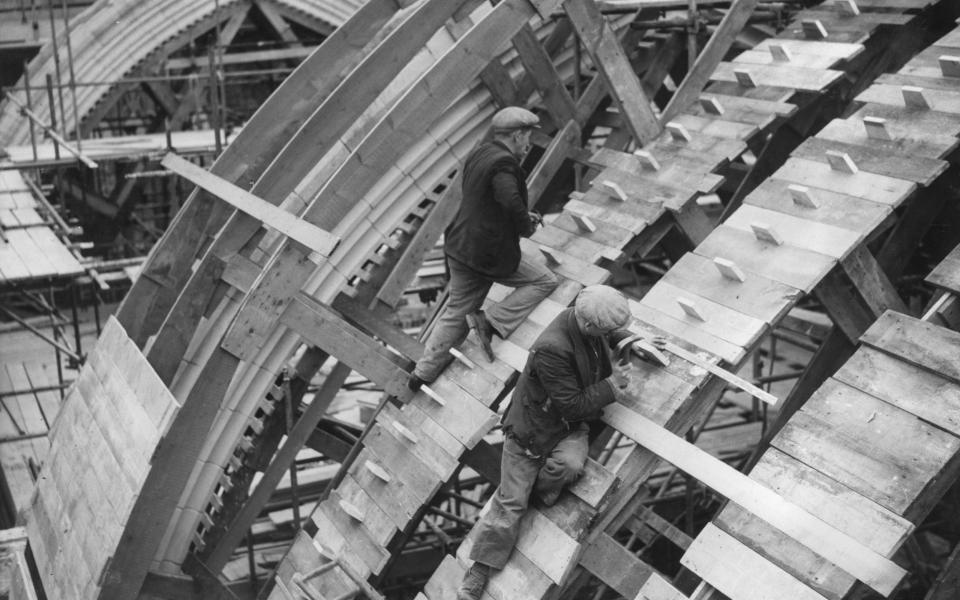Why this forgotten architect deserves his place among England’s master cathedral builders

- Oops!Something went wrong.Please try again later.
- Oops!Something went wrong.Please try again later.
It is surprising, and rather unfair, that the architecture of Edward Maufe (1882-1974) is so little known. Or perhaps it is safer to say that the work that is well known is not widely recognised as his. His masterpiece is Guildford Cathedral, viewed daily by thousands from their cars as they drive along the A3; but he also designed the Air Forces Memorial, at Runnymede. What both have in common, despite their contemporary looks, is a connection with tradition. Maufe designed fine buildings that have stood the test of time.
I first encountered him while at university. He designed the Chapel Court and North Court at St John’s College, Cambridge, a room in which was occupied by one of my friends. To the unobservant, the buildings, as one approaches them, look to be in the manner of a 1930s apartment building, whether the luxurious art-deco blocks that one finds in west London, or the former council flats in the capital’s inner suburbs built under the direction of Herbert Morrison for the London County Council in the years just before the war. The Pevsner architectural guide to Cambridgeshire is sniffy about Maufe’s work here, saying he misses an opportunity to present a more magnificent building where it backs onto one of Cambridge’s busiest roads: “The mixture of new and traditional elements betrays Maufe’s membership of a generation too old to go over to modernism but too young to ignore its imperatives altogether.”

This is unfair. Maufe also had to allow for his work abutting George Gilbert Scott’s cathedral-like chapel at St John’s, which he did tastefully. And when one gets inside Maufe’s buildings, one notices the high specification of the staircases themselves, the doors and door handles, the iron windows so typical of the period, and the fixtures and fittings in the kitchens and bathrooms. Above all, not least thanks to the fenestration but also because of the generosity of scale, the rooms have an airiness that is as far from the student’s garret as could be imagined. Thirty years after first encountering this architecture, I became reacquainted with it when my son lived in one of Maufe’s rooms in the same court.
Maufe – a Yorkshireman born Edward Muff but whose father changed the family name by deed poll to what was claimed to be its original form – was apprenticed to an architectural practice in London in 1899. His family moved in 1904 to Kent, to live in a contemporary house – Red House, in Bexleyheath – designed by Philip Webb for William Morris. Webb is regarded as the progenitor of the Arts and Crafts movement, and the young Maufe was deeply influenced by his style. Private houses, notably Kelling Hall, in Norfolk, proliferated among his early work, and reflect the inspiration of Webb, Morris and Edwin Lutyens. He had hoped, after the Great War (in which he fought), to move to larger-scale projects, and although the design he submitted for the Palace of Industry at the 1924 British Empire Exhibition was rejected, it brought him notice. He started to build churches, which display his own evolving aesthetic: St Bede’s Clapham, and St Saviour’s, in Acton. The former, now a social club for the deaf, has a high, narrow nave and lancet-style window lights that pre-empt Guildford Cathedral. The latter, now the St Thomas Syrian Orthodox Church, has the same tall nave, gothic windows and restrained brickwork.

Maufe won the competition to build Guildford Cathedral in 1932. Critics attacked the design as being anachronistic at the time, and all the more so by the time the building was finished in 1961. The odd proportions of height and breadth provoke differing opinions: I find his use of space exceptional, and it is in that respect that he fits so well into the tradition of English cathedral builders. The red brick and the austere interior and exterior mark the building out as 20th century, the narrow horizontal windows in the tower date the design to the 1930s. It is the natural successor to Giles Gilbert Scott’s more expansive, lumbering design at Liverpool, which began construction 30 years earlier. Maufe’s legacy may be less celebrated, but it is worth examining none the less.

